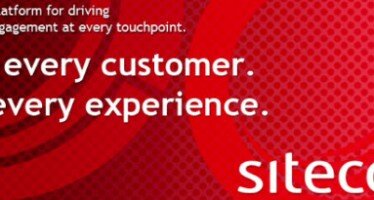Adobe, Salesforce Top Forrester’s List of Marketing Software Suites

This is a new report for Forrester – , but the vendors that make the list are not new by any means. Most have a long history of integrating and building marketing software solutions. By long I mean at least 3-4 years, some longer, but marketing has really changed the most in the last few years and the tools have had to change with it.
This is how Forrester defined enterprise marketing software suites:
An integrated portfolio of marketing technology products that provide analytics, automation and orchestration of insight-driven customer interactions to support inbound and outbound marketing.”
There are eight vendors in this list and they reside along the wave as follows:
- Leaders: Adobe, salesforce.com
- Strong Performers: SAS, Oracle, Teradata, IBM
- Contenders: SAP, Marketo
Noticeably missing are vendors like Sitecore, Ektron and Acquia, which all have much of the marketing software included in the definition by Forrester, but are not considered Marketing Software Suites. But I guess they remain content management at the core, where these others have offerings that don’t required content management. The “cloud” part of equation is also in question here. The vendors that make this wave offer 90% of 23 discrete marketing capabilities and have a separate Profit and Loss division for this software (another reason you don’t see more vendors like Sitecore, Ektron and Acquia).
There is a range of functionality in these marketing suites, much of it acquired and then integrated to provide a complete solution. Forrester lists functionality such as campaign management, digital messaging across channels, MRM, analytics and more.
In its survey of 53 vendor client references, most have marketing technology strategy that the department follows, and almost as many want to cut the number of vendors that supply marketing technology. But, also note that at least half agree that one vendor can’t provide every needed capability. Best of breed is not necessarily the answer, but the Suite can only go so far, that’s my takeaway here.
How the Marketing Software Suite Vendors Match Up
I’m not going to go through every vendor, or tell you how each one scored against Forrester’s criteria. You can read the report to get all the details. Here’s a quick summary of interesting points though:
- In terms of capabilities SAS scored the highest, followed by Adobe.
- Although SAS score highest on capabilities, they scored lower is app usability. Here, Adobe and Salesforce tied for top, followed by Marketo.
- For best at integrating capabilities SAP, SAS, then Adobe had the best marks.
- Adobe nailed all in terms of Strategy, Partnerships and Customer Satisfaction and with Financials, yet Oracle topped the list for biggest install base.
- IBM, Salesforce and SAP had equally strong Partnership strategies as Adobe.
- oracle and salesforce both had strong product strategies as well, just not as good as Adobe.
A few vendor specific highlights as told by Forrester:
- Adobe, while the best of all vendors, has room for improvement on journey mapping and measurement. The measurement part we have seen much improvement lately.
- Salesforce’s Journey Builder product is a key highlight, as is their open platform, but MRM isn’t there and the analytics needs work.
- SAS has its Customer Intelligence Portfolio, but pricing and packaging needs to improve focusing on digital and not data.
- IBM’s Experience One has some overlapping functionality and inconsistencies, they need better integration to move ahead on this list.
- Oracle is working hard on a unified suite, but Forrester says it will take time.
- Teradata’s Integrated Marketing Cloud could use some user experience improvements.
- Marketo is not an enterprise solution, best suited for B2B as a lead-to-revenue management tool or for small scale B2C.
- SAP needs to clean up its offering packaging and messaging, but it does have a great content and commerce strategy.
These are eight marketing software suites, but a lot more solutions are out there. The marketing technology market is huge, almost too big sitting at a US$20 billion market. It’s no wonder marketers are confused. What software do I need? What does a particular software provide? What integrates well with it? I’m not sure even the analysts agree on what the market should really look like.
Scott Brinkler offers his perspective on selecting marketing software. He talks about the decision as “frames” and “fields”, where the frame is the type of technology you determine you need (e.g. campaign management, digital experience, etc..) and the field is the set of vendors you will consider. Some vendor’s software falls into different “frames” depending on how you look at it and how the analysts have categorized it for their reports. In the end, it’s all very much a judgement call by the selection team. Read his post for tips on how to best move forward.
The art of making marketing technology decisions is determining the best frame and field criteria within your business context. Don’t inadvertently relinquish that control to vendors, analysts, or even marketing tech bloggers — anyone who doesn’t fully understand your business or isn’t fully aligned with your interests. Instead, those third-parties should be viewed as resources for your own framing.
Share and Enjoy
Related Articles
Making Sense of Video Marketing with Vidyard’s Michael Litt
Vidyard, Brightcove, Kaltura, Wistia, uStudio, Ramp, Ooyala. These are all companies that created video marketing platforms. But they aren’t all
Share and Enjoy
It’s NaNoWriMo – Get Your Writing on!
November is National Novel Writing Month where writers from across the globe commit to writing a 50,000 word novel. It’s
Share and Enjoy
Interview: Darren Guarnaccia, CSO Sitecore, Talks About the Connected Customer
When you want to get handle on what’s happening in the customer experience industry, reach out to a CSO (Chief





